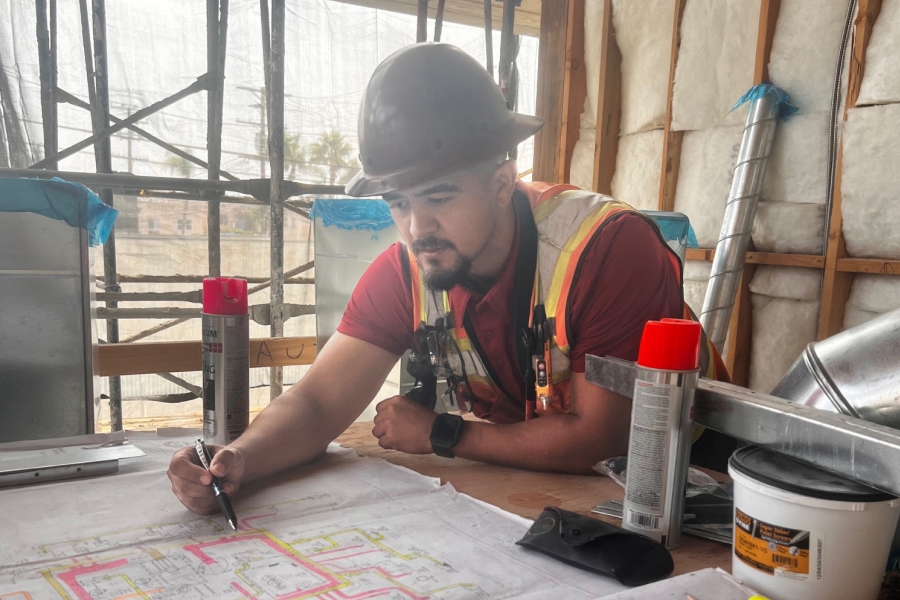Illustration by Shannon Wright
Tiara Hughes was in second grade when she was first introduced to architecture. She attended a majority-Black elementary school, and students were asked to create a piece of artwork for a fundraiser.
“I decided that my contribution would be drawing buildings from books verbatim; it was a gift that I didn’t realize I had at the time,” she said.
The following year, Hughes was introduced to the concept of a blueprint—”I remember the feel and smell,” she said—and she could envision doors, windows and floorplans. Still in elementary school, Hughes knew the career she wanted to pursue when she grew up—without ever hearing the word architect.
The word came out of a teacher’s mouth the following year, when Hughes was in fourth grade, and her mind was made. By high school, Hughes enrolled in architecture and engineering classes at a predominantly white institution, where she was the only female or person of color in class. “It was really telling of what the industry was like and how much early exposure matters,” Hughes said.
Hughes went on to study architecture at Drury University in Springfield, Missouri, graduating in 2015 as the first of her extended family to receive a college degree. It wasn’t until she entered the workforce that she realized just how white the profession really was.
In 2018, 66% of architects who completed a training program most architectural students take in preparation for getting their license—the AXP—were white, while 60% were men. Although those percentages have improved from a decade earlier in 2009, when nearly 80% of AXP completions were white, with 67% male, the industry remains woefully lacking minority representation from top to bottom.
After graduation, Hughes quickly joined the National Association of Minority Architects (NOMA), helped the organization put on its 2018 conference in her hometown of Chicago. Today, in addition to working as a senior urban designer at Chicago-based SOM, Hughes is also an adjunct professor at the Illinois Institute of Technology, Commissioner for the Chicago Landmarks Commission, as well as NOMA’s national communications lead.
“Thinking back to college, I never learned about Black architecture,” Hughes said. “I had no Black professors or lecturers; I didn’t even see Black architects written about in textbooks. You have to see yourself in a profession to relate to it. We are losing a huge percentage of potential students that want to join this field because of lack of support and resources.”
Why little progress?
In 1968, architect Whitney M. Young Jr. famously spoke about the racial disparity in architecture at that year’s American Institute of Architects (AIA) convention in Portland, Oregon. He voiced what many at the time knew but wouldn’t say: that the industry was largely white, with Black architects representing only 2% of licensed architects at the time. It was time to do better.
“The interesting thing is that if you think of that speech from 52 years ago, where Whitney Young ridiculed the profession for a lack of representation and then look at today, it gives you pause,” said Jonathan Moody, CEO of Moody Nolan, the largest Black-owned architecture firm in the U.S., based in Columbus, Ohio. “In 2020, there are 2,300 Black architects out of 115,000 nationally, which is just around 2%.”
There are many reasons for the lack of Black representation in architecture.
Lack of exposure, licensing drop-off
Many architects are second- or third-generation, making knowledge of the profession accessible at a young age. “Part of it is flat out exposure; it is hard to get out of a cycle,” Moody said. “Kids need introductions to architecture at much earlier ages to formulate ideas about their career paths.”
Both Hughes and Moody agree that the industry sees a significant drop-off between Black students graduating from college with architecture degrees and earning accredited licenses. “While 5% of architecture students are Black,” Hughes said, “only 2.5% of them are getting licensed.”
In 2018, 66% of architects who completed a training program most architectural students take in preparation for getting their license—the AXP—were white, while 60% were men.
Unlike law students, who are required to take and pass a state’s Bar Exam right after law school, with the ability to start practicing immediately thereafter, architecture students are required to accrue the equivalent of five years’ work experience before they are able to take a series of six exams, some of which have a 40% pass rate. Then there’s the cost. “It costs $235 per exam, which can be a huge burden on families and cause a drop-off,” Hughes said.
There is quite a bit of talk about changing the licensing process—an effort supported by both Hughes and Moody—but it is not yet widely accepted. “If our goal is to bring more people into the profession, things need to change,” Moody said. “As I was going through the tests, I had a mentor in my Dad [Curtis Moody, Moody Nolan’s founder] to guide and counsel me, but not everyone has that.”
Improvements on the horizon?
Thankfully, there are many programs working to address these issues, namely out of NOMA. Project Pipeline is a wide-reaching effort that helps Black students starting at a young age get the support they need all the way through the licensing process. Today, the project includes national summer camps (they were virtual in 2020) for students of color between 6th and 12th grades.
NOMA has programs for high school students that connect them with projects for real clients, and a Foundation Fellowship that connects college kids with winter and summer fellowships at firms like SOM, Moody Nolan and others.
What can firms do
These programs may be helping to change the industry, but architecture firms—small and large—can still do quite a bit to help close the racial disparity gap.
Hughes outlines the following things firms can do right away:
- Internally reflect and be honest about the firm’s experiences and what your firm can do differently.
- Listen and educate.
- Be considerate and understanding. “Black people don’t have every answer,” she said.
- Don’t be defensive. “We have to be uncomfortable for the next 400+ years to undo the last 400 years,” she said.
- Hire more Black people. “If you are a mid-to-large firm and you have no Black people, you are part of the problem,” Hughes said. “Include equitable pathways for Black people and diverse designers in their careers.”
- Don’t accept excuses. “Sometimes I hear people saying they don’t know where Black architects are,” she said. “NOMA is a national organization and we can connect you to Black talent.”
- Have an equitable approach. “Ask yourself: How are you supporting Black people? If it is the same as white people, that is part of the problem,” she said. “Black people need additional support, need more fostering growth as leaders.”
- Revise your policies. “We too often rely on policies put in place by racist people from long ago; they are the driving force in the world today and continue to perpetuate systemic racism,” Hughes said. “That needs to change.”
Katie Morell is an independent journalist based in Bend, Oregon. Read more of her work at katiemorell.com.












